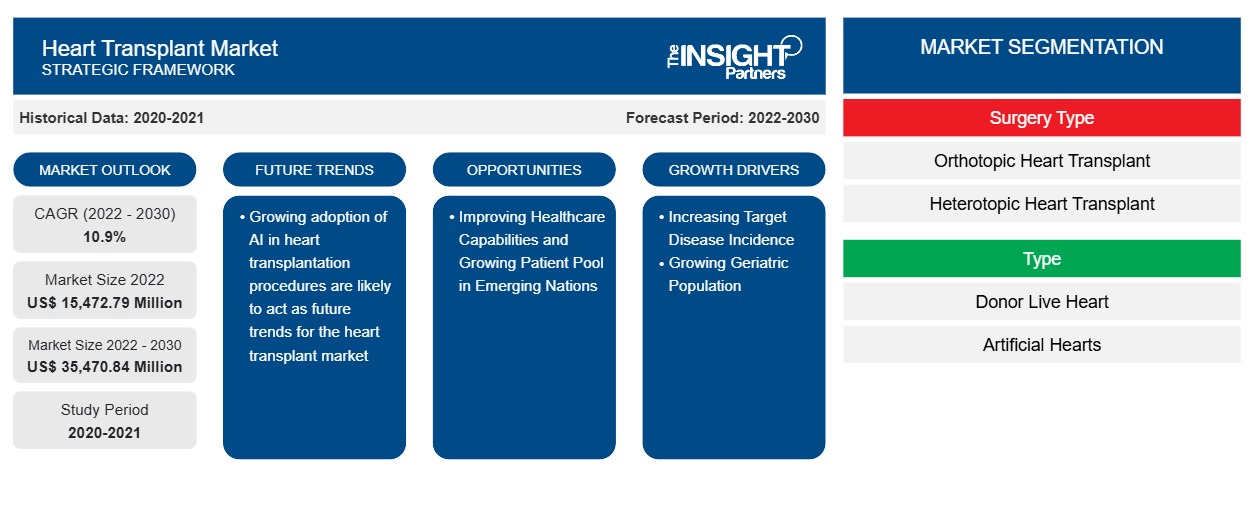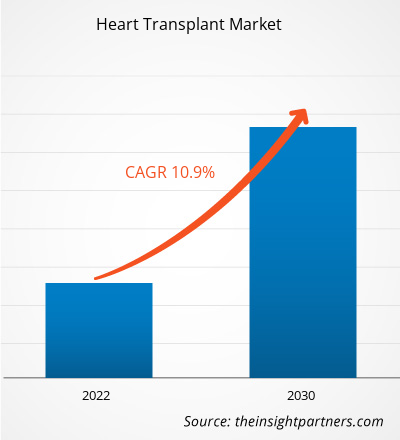The heart transplant market size is projected to reach US$ 35,470.84 million by 2030 from US$ 15,472.79 million in 2022. The market is expected to register a CAGR of 10.9% during 2022–2030. Growing adoption of AI in heart transplantation procedures for detection of early signs and seriousness of the host rejection post-heart transplantation are likely to remain key trends in the market.
Heart Transplant Market Analysis
The number of geriatric population and patients suffering from cardiovascular diseases is increasing, which are the key market drivers for market growth. The demand for cardiac surgeries and treatments is also increasing as more and more people are getting prone to cardiovascular diseases across the world, which is also driving up the heart transplant market growth. The demand for heart transplants is further increasing because of the aging population and large number of individuals diagnosed with high blood cholesterol levels. Furthermore, the increasing mortality rate due to heart failure is also a factor bolstering the market growth. Both the cases of heart failure and coronary heart disease have increased significantly in the last decade. These cardiovascular diseases often require heart transplants, so this is one of the crucial elements driving the growth of the heart transplant market.
Heart Transplant Market Overview
Companies operating in the heart transplant market are focusing on collaborations, expansions, agreements, partnerships, and launching new products that help them increase their revenue, expand their geographical reach, and enhance their capacities to serve a larger than existing customer base. In 2022, a new AI system was designed known as the Cardiac Rejection Assessment Neural Estimator (CRANE), which can be used in tandem with medical assessments for rapid and precise diagnosis. In 2020, the National Institute of Health granted US$ 3.2 million for the study based on the exploration of the capabilities of AI in heart transplants. Furthermore, a few of the major contributors to the rising prevalence of CVDs leading to the market growth are ethnicity and family history. Other notable factors include increasing tobacco consumption, hypertension; and diseases such as obesity, dyslipidemia, and diabetes that are further expected to drive the market growth in near future.
Customize This Report To Suit Your Requirement
You will get customization on any report - free of charge - including parts of this report, or country-level analysis, Excel Data pack, as well as avail great offers and discounts for start-ups & universities
Heart Transplant Market: Strategic Insights

-
Get Top Key Market Trends of this report.This FREE sample will include data analysis, ranging from market trends to estimates and forecasts.
Heart Transplant Market Drivers and Opportunities
Growing Geriatric Population Susceptible Heart Related Problems to Favor Market
According to the WHO, the aging population worldwide will grow to ~2.1 billion by 2050 from from ~1 billion in 2019. The US Census Bureau further estimates that the US population aged 65 and above would surge by 20% by the end of 2030. As per a study by Emory Healthcare, ~1.4 million people in the US over the age of 65 suffer from congestive heart failure, and more than 5% of people aged 60–69 years have this heart condition. Congestive heart failure is one of the most common diagnoses in hospitals with patients of 65 years and above age, which led to 875,000 hospitalizations in the US in 2021. Artificial heart surgeries are commonly used in managing heart failure in the geriatric population. Hence, the growing elderly population, along with the increasing prevalence of heart failure, fuels the heart transplant market growth.
Improving Healthcare Capabilities and Growing Patient Pool in Emerging Nations
Emerging countries such as India, China, Argentina, Brazil, the UAE, and South Africa are expected to offer significant growth opportunities for heart transplant market players mainly due to flourishing R&D landscape, rising patient population, growing CVD awareness, improving healthcare infrastructure, burgeoning disposable incomes, and relatively lenient policies compared to developed economies. The number of surgical centers and hospitals in developing markets would continue to grow with burgeoning healthcare spending and a rising target patient population. Therefore, the development of healthcare facilities in the developing economies, along with the rise in the number of hospitals, would in turn, result in the elevated number of heart transplantation surgeries in the coming years, creating lucrative opportunities for the heart transplant market players.
Heart Transplant Market Report Segmentation Analysis
Key segments that contributed to the derivation of the Heart Transplant market analysis are surgery type, type, and end user.
- Based on surgery type, the heart transplant market is divided into orthotopic heart transplantation and heterotopic heart transplantation. The orthotopic heart transplantation segment held the largest market share in 2022 and is expected to register highest CAGR during the forecast period.
- By type, the market is bifurcated into donor live heart and artificial heart. The donor live heart segment held the largest share of the market in 2022. However, the artificial heart segment is anticipated to register highest CAGR during 2020–2030.
- Based on end user, the heart transplant market is segmented into hospitals, cardiac centers, and others. The hospitals segment held the largest market share in 2022 and is expected to register highest CAGR during the forecast period.
Heart Transplant Market Share Analysis by Geography
The geographic scope of the heart transplant market report is mainly divided into five regions: North America, Asia Pacific, Europe, Middle East & Africa, and South & Central America.
North America has dominated the heart transplant market. Factors leading to the growth of the heart transplant market in North America are an upsurge in the geriatric population, the prevalence of cardiovascular diseases, and an increase in heart failure cases. The US held the largest market share of the heart transplant market in 2022. According to data by the American Heart Association (AHA), annually ~1 million new heart failure cases are registered in the US, and it is further estimated that more than 8 million people would suffer from heart failure by 2030. In addition, the US Food and Drug Administration (FDA) is increasingly approving various heart transplant procedures and products in the country. Further, the presence of major companies also benefits the market in the US. For instance, in April 2022, TransMedics Group, Inc. received premarket FDA approval for its OCS Heart.
Heart Transplant Market Regional Insights
The regional trends and factors influencing the Heart Transplant Market throughout the forecast period have been thoroughly explained by the analysts at The Insight Partners. This section also discusses Heart Transplant Market segments and geography across North America, Europe, Asia Pacific, Middle East and Africa, and South and Central America.
Heart Transplant Market Report Scope
| Report Attribute | Details |
|---|---|
| Market size in 2022 | US$ 15,472.79 Million |
| Market Size by 2030 | US$ 35,470.84 Million |
| Global CAGR (2022 - 2030) | 10.9% |
| Historical Data | 2020-2021 |
| Forecast period | 2022-2030 |
| Segments Covered |
By Surgery Type
|
| Regions and Countries Covered |
North America
|
| Market leaders and key company profiles |
|
Heart Transplant Market Players Density: Understanding Its Impact on Business Dynamics
The Heart Transplant Market is growing rapidly, driven by increasing end-user demand due to factors such as evolving consumer preferences, technological advancements, and greater awareness of the product's benefits. As demand rises, businesses are expanding their offerings, innovating to meet consumer needs, and capitalizing on emerging trends, which further fuels market growth.

- Get the Heart Transplant Market top key players overview
Heart Transplant Market News and Recent Developments
The heart transplant market is evaluated by gathering qualitative and quantitative data post primary and secondary research, which includes important corporate publications, association data, and databases. A few of the developments in the heart transplant market are listed below:
- Terumo Aortic announced the first North American implant of a novel custom-made hybrid device, Thoracoflo, which was used for treating patients with thoracoabdominal aortic disease through a less invasive surgical technique than traditional open surgical repair. (Terumo Corp, Press Release, April 2023)
- OneVentures Healthcare Fund III, funded Cormorant Asset Management with US$18 million in capital. The funds would help the business in hiring important executives and supporting the ongoing R&D and early feasibility studies in human trials. The business will be able to add important roles, such as those in research and development and the C-suite, and double in size owing to this finance. Positioned to progress preclinical work, the company hopes to do the early feasibility study for First in Human by the end of the year. The Total Artificial Heart will be the subject to early feasibility investigations in humans, with funding provided. (BiVACOR Inc, Press Release, March 2023)
- BioVentrix Acquired MateraCor Inc and their lead product. MateraCor, Inc. is a company that uses injectable hydrogel based on alginate for stopping the progression of heart failure and reverse it. (BioVentrix, Press Release, January 2022)
- The company performs inorganic growth strategies to reach more customers. Hunniwell Lake Ventures, LLC, a venture capital investment firm, with its headquarter in California, acquired SynCardia. As a result, SynCardia now has the operational and financial means to guarantee its continued expansion and success both domestically and internationally. In order to assist more patients, the company continues to create cutting-edge medical devices and explore new indications because of the received fundings. (SynCardia Systems LLC, Press Release, September 2021)
Heart Transplant Market Report Coverage and Deliverables
The “Heart Transplant Market Size and Forecast (2020–2030)” report provides a detailed analysis of the market covering below areas:
- Heart transplant market size and forecast at global, regional, and country levels for all the key market segments covered under the scope
- Heart transplant market trends as well as market dynamics such as drivers, restraints, and key opportunities
- Detailed PEST and SWOT analysis
- Heart transplant market analysis covering key market trends, global and regional framework, major players, regulations, and recent market developments
- Industry landscape and competition analysis covering market concentration, heat map analysis, prominent players, and recent developments for the heart transplant market
- Detailed company profiles
Frequently Asked Questions
What is the expected CAGR of the heart transplant market?
Which region dominated the heart transplant market in 2023?
What are the driving factors impacting the heart transplant market?
Which are the leading players operating in the heart transplant market?
What are the future trends of the heart transplant market?
What would be the estimated value of the heart transplant market by 2031?
- Historical Analysis (2 Years), Base Year, Forecast (7 Years) with CAGR
- PEST and SWOT Analysis
- Market Size Value / Volume - Global, Regional, Country
- Industry and Competitive Landscape
- Excel Dataset
Recent Reports
Testimonials
Reason to Buy
- Informed Decision-Making
- Understanding Market Dynamics
- Competitive Analysis
- Identifying Emerging Markets
- Customer Insights
- Market Forecasts
- Risk Mitigation
- Boosting Operational Efficiency
- Strategic Planning
- Investment Justification
- Tracking Industry Innovations
- Aligning with Regulatory Trends





















 Get Free Sample For
Get Free Sample For